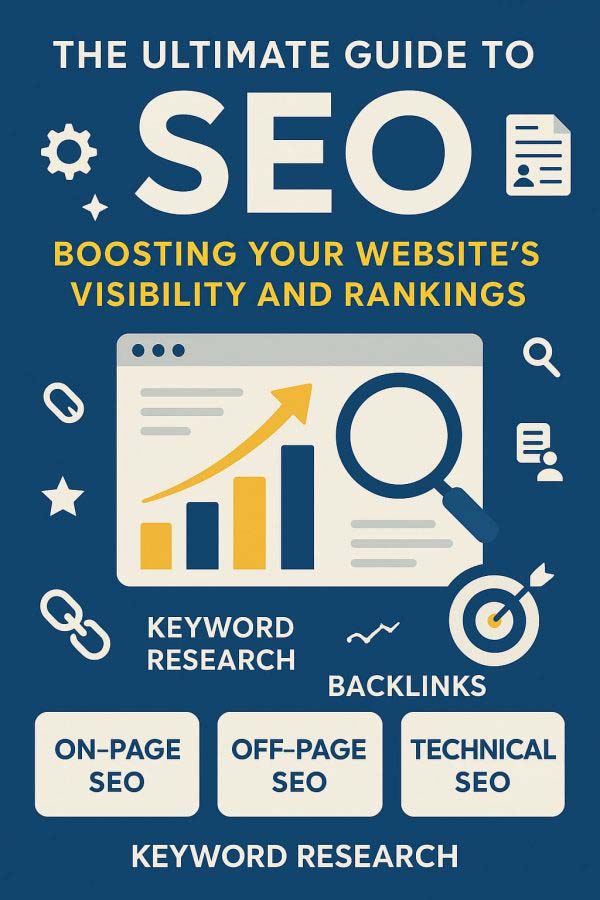The Ultimate Guide To SEO
Introduction
In today’s digital world, Search Engine Optimization (SEO) is not just a buzzword—it’s a necessity. If you want your website to be discovered by potential customers, generate organic traffic, and grow your brand online, you need a strong SEO strategy. But what exactly is SEO, and how can you use it to your advantage?
In this comprehensive guide, we’ll cover everything you need to know about SEO, including key strategies, best practices, and must-use SEO tools. Whether you’re a beginner or a business owner looking to scale your online presence, this blog is your one-stop resource.

What is SEO?
SEO (Search Engine Optimization) is the process of optimizing your website to rank higher on search engines like Google, Bing, and Yahoo. It involves a combination of on-page SEO, off-page SEO, and technical SEO techniques to improve visibility and drive organic traffic (non-paid visitors).
The ultimate goal of SEO is to make your website appear on the first page of search engine results pages (SERPs) for specific keywords relevant to your business or content.
Why is SEO Important?
- Increased Visibility
Ranking higher in search results increases the chances of people finding your website. - Organic Traffic Growth
Unlike paid ads, organic SEO traffic is free and long-term. - Credibility and Trust
Users tend to trust websites that appear at the top of Google. - Better User Experience (UX)
SEO also focuses on improving the user experience through faster load times, mobile optimization, and easy navigation.
Types of SEO
1. On-Page SEO
This involves optimizing elements within your website:
- Keyword Research: Finding the right search terms your audience is using.
- Meta Tags: Title tags and meta descriptions that include target keywords.
- Content Optimization: Creating high-quality, keyword-rich content.
- Internal Linking: Linking to other relevant pages within your site.
2. Off-Page SEO
This refers to actions taken outside your website:
- Backlinks: Getting links from other authoritative websites.
- Social Media Signals: Shares, likes, and mentions can impact rankings.
- Guest Posting: Writing articles for other websites to earn links.
3. Technical SEO
This focuses on the backend of your site:
- Website Speed: Fast-loading sites rank better.
- Mobile Optimization: Ensuring your site works well on smartphones.
- Secure Website (HTTPS): Google favors secure sites.
- XML Sitemaps and robots.txt: Help search engines crawl your site properly.
How to Do SEO: Step-by-Step
Step 1: Conduct Keyword Research
Use tools like Google Keyword Planner, Ahrefs, or Ubersuggest to find relevant keywords with high search volume and low competition.
Example keywords:
- SEO strategies for small businesses
- How to rank higher on Google
- Best SEO tools 2025
- On-page SEO checklist
Step 2: Optimize Your Content
Once you have your keywords:
- Include them naturally in your headings, paragraphs, and URLs.
- Write original, valuable content that answers users’ questions.
- Add images with proper ALT tags and optimize file sizes.
Step 3: Build Backlinks
Get other websites to link back to you:
- Reach out to bloggers or influencers in your niche.
- List your business in online directories.
- Share content on social media to increase exposure.
Step 4: Improve Technical SEO
Use tools like Google Search Console and Screaming Frog to identify:
- Crawl errors
- Duplicate content
- Broken links
- Mobile usability issues
Top SEO Tools to Use in 2025
- Ahrefs – Best for backlink analysis and keyword research
- SEMrush – All-in-one SEO and marketing toolkit
- Yoast SEO – Best WordPress SEO plugin
- Moz Pro – Great for tracking keyword rankings
- Google Search Console – Monitor your site’s performance and indexing
Common SEO Mistakes to Avoid
- Keyword Stuffing: Overloading content with keywords can hurt your rankings.
- Ignoring Mobile Users: More than 50% of traffic comes from mobile devices.
- Poor Quality Backlinks: Spammy or irrelevant links can lead to penalties.
- Neglecting Analytics: You must track your progress using tools like Google Analytics.
Latest SEO Trends You Should Know
- Voice Search Optimization: Optimize content for how people speak.
- AI and Machine Learning: Google’s algorithms are getting smarter.
- Video SEO: Use YouTube and embedded videos to engage users.
- Core Web Vitals: User experience metrics are more important than ever.
Conclusion
Investing in SEO is one of the smartest decisions you can make for your website or online business. It may take time to see results, but the long-term benefits of increased traffic, better rankings, and higher conversions are worth it.
Start small—optimize your content, use the right keywords, and improve your website’s performance. As your SEO strategy grows, so will your online presence.
Final SEO Tip
Remember: SEO is not a one-time task. It’s a continuous process that evolves with algorithms and user behavior. Stay updated with SEO best practices, monitor your site’s performance, and always put the user experience first.





Comments are closed